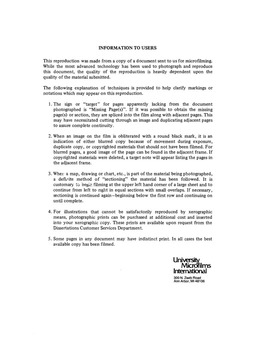| dc.contributor.author | Watt, Doris Jane, | en_US |
| dc.date.accessioned | 2013-08-16T12:28:52Z | |
| dc.date.available | 2013-08-16T12:28:52Z | |
| dc.date.issued | 1983 | en_US |
| dc.identifier.uri | https://hdl.handle.net/11244/5102 | |
| dc.description.abstract | I investigated the general hypothesis that plumage variability in winter flocking birds acts as a status signal using three species: Harris' sparrow (Zonotrichia querula), white-crowned sparrow (Z. leucophrys) and white-throated sparrow (Z. albicollis). Employing an operational definition of "signaling" whereby behavior of focal birds (potential receivers) was recorded in the presence of birds having specific color types (potential signalers), and applying inter- and intra-specific comparative methods, I assessed groups that were relatively monomorphic (therefore unlikely to be status signalers) and compared their behavior with groups of birds of more varicolored plumage. Groups of variably-plumaged birds exhibited increased avoidance behavior compared to groups with less variability in plumage, supporting the status signaling hypothesis, but only groups of mixed-age birds in the Harris' and white-crowned sparrows exhibited increased avoidance of strangers, a necessary requirement of a status signaler. An alternative hypothesis to explain variable plumage, facilitated individual recognition, was also supported in the two more variably colored species: both white-throated and Harris' sparrows had high correlations between attack and avoidance behaviors. None of the white-crowned sparrow groups, monomorphic or mixed age, exhibited attack-avoidance correlations as high as the more variably colored species. I also investigated the degree to which the signal might be correlated with dominance status in Harris' sparrows using a plumage index, 7 morphological and 8 plumage characteristics. A series of multivariate analyses showed that, in general, dark-throated birds dominated light-throated birds as expected but, within these broad classes, wing length rather than throat color, was the best overall predictor of dominance. These results support the conclusion that Harris' sparrow plumage variability is not well correlated to dominance within age classes and is probably not used to signal dominance, except between age classes. | en_US |
| dc.description.abstract | Studies of competition and starvation in mixed-sex groups of white-throated sparrows showed that females in their home aviary could dominate introduced males, some subordinate female birds survived periods of limited food while some dominate males did not, and therefore, females may not be at a severe disadvantage in winter flocks compared to males. The best predictor for surviving starvation was heavier body weight per wing length during pre-starvation competition. | en_US |
| dc.format.extent | x, 121 leaves : | en_US |
| dc.subject | Biology, Zoology. | en_US |
| dc.title | Plumage coloration and dominance behavior in three species of sparrows of the genus Zonotrichia. | en_US |
| dc.type | Thesis | en_US |
| dc.thesis.degree | Ph.D. | en_US |
| dc.thesis.degreeDiscipline | Department of Biology | en_US |
| dc.note | Source: Dissertation Abstracts International, Volume: 44-02, Section: B, page: 0429. | en_US |
| ou.identifier | (UMI)AAI8313783 | en_US |
| ou.group | College of Arts and Sciences::Department of Biology | |
